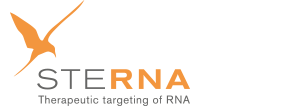Marburg, Germany, September 05, 2018
- Key preparatory steps to conduct phase IIb trials initiated, including CMC and regulatory activities in the EU and US
- Devices for SB010 in asthma selected, oral formulation work for SB012 in ulcerative colitis (UC) started
Sterna biologicals GmbH & Co. KG (“sterna”), an innovative clinical-stage immunology company developing novel treatments for chronic inflammatory diseases, today provided an update on its preparations for phase IIb clinical development of its GATA-3 antagonist drug candidates SB010 and SB012.
Sterna’s antisense-based technology offers a highly differentiated approach to comprehensive and specific Th2 pathway downregulation via GATA-3, the master transcription factor regulating Th2-driven inflammatory diseases, including asthma, eCOPD1, ulcerative colitis (UC), and atopic dermatitis. Sterna successfully completed Phase IIa trials with SB010 in asthma, as well as eCOPD, and with SB012 in UC and is now preparing for the initiation of Phase IIb trials with SB010 in asthma and SB012 in UC.
Meetings planned with regulatory agencies in US and Europe.
Sterna is planning to meet with the US Food and Drug Administration (FDA) as well as with the European Medicines Agency (EMA) in H1 2019 to gain their input and advice on the design of the Phase IIb programs for SB010 in asthma and SB012 in UC. These programs are being designed with some of the world’s leading experts in these therapeutic areas. Sterna plans to announce further details as these programs advance.
Device bridging study completed with SB010
To enable selection of the optimal nebulizers for late-stage development and commercialization of SB010 in respiratory indications, sterna successfully completed in vitro device evaluation studies. Based on the results of these studies, sterna selected two hand-held high efficiency nebulizer systems for their compatibility with SB010’s formulation in terms of nebulization characteristics such as aerodynamic particle size distribution and delivered dose.
Oral formulation prototype for SB012 started, final formulation for Phase II expected in H2 2019
To enable late-stage development of SB012 and provide for a highly attractive commercial product profile, sterna entered into a development agreement with a leading oral formulation company. Under this agreement, sterna and its partner are currently developing an oral formulation prototype. This version will then undergo feasibility testing and optimization for use in clinical trials and final commercial product configuration.
Christian Pangratz, CEO and Managing Director of sterna, said: “There is a lot of work that needs to be done to prepare a product candidate for later stage clinical testing, but we are very pleased with the rapid progress we have made so far. All the work today and going forward is building upon the very promising Phase IIa data readouts for SB010 and SB012. The solid safety data and strong efficacy signals are highly supportive of our differentiated approach to comprehensively and specifically downregulate the Th2 pathway via the inhibition of master transcription factor GATA-3. We are very excited to be in a position to advance our work to the next stage of clinical development, with the ultimate goal of bringing our novel therapies to patients who are in desperate need of well tolerated, more effective treatment options.”
Sterna currently has four drug candidates in its pipeline based on its unique scientific approach of GATA-3 downregulation.
ABOUT SB010 AND SB012
Sterna biologicals’ drug candidate SB010 comes in a liquid inhaled formulation, while SB012 is formulated as an enema and in an orally available carrier system. All programs leverage sterna`s proprietary and patent-protected active pharmaceutical ingredient hgd40, a DNAzyme and first-in-class GATA-3 antagonist.
GATA-3 is the master transcription factor regulating Th2-driven inflammatory diseases such as ulcerative colitis, atopic dermatitis, eCOPD and asthma. By inhibiting GATA-3, the expression of downstream cytokines, interleukin IL-4, IL-5, and IL-13, which cause inflammation, is down regulated. In pre-clinical and clinical development, hgd40 was found to be well tolerated with first signs of efficacy. DNAzymes are single-stranded DNA molecules comprising a central catalytic domain flanked by two binding domains. The binding domains attach to a specific sequence of targeted mRNA, such as GATA-3 mRNA in the case of hgd40. After binding to the target, the catalytic domain then cleaves the mRNA, thereby inhibiting relevant downstream cytokine expression.
PHASE IIa RESULTS - ASTHMA
In a randomized, double-blind, placebo-controlled parallel group, multi-center phase IIa trial, SB010 led to a significant improvement in lung function in both early (immediate reaction post allergenic exposure, EAR) and late phase (3-8 hours post allergic exposure, LAR) asthmatic response. SB010 attenuated the decline in mean LAR under the FEV curve (AUC) by 34% (decline in median LAR AUC attenuated by 48%) compared to a 1% worsening in mean lung function in the placebo group (p=0.02). SB010 also attenuated the decline in mean EAR AUC by 11% (decline in median EAR AUC attenuated by 15%) compared to a 10% worsening in mean lung function in the placebo group (p=0.03). SB010 was safe and well tolerated. No serious treatment emergent adverse events occurred in either treatment group.
PHASE IIa RESULTS - ULCERATIVE COLITIS
The SECURE study was a prospective, multi-center, randomized, double-blind, placebo-controlled trial that enrolled a total of 20 patients with moderate to severe ulcerative colitis. SB012 was safe and well tolerated and led to marked clinical and endoscopic improvement in patients with active ulcerative colitis. At day 28, there was a statistically significant improvement in the Mayo Score in the SB012 group compared with the placebo group (p=0.04). Clinical remission, clinical response, mucosal healing rates and endoscopic response at days 28 and 56 were also assessed.
1eCOPD: chronic obstructive pulmonary disease with the presence of sputum eosinophilia.
